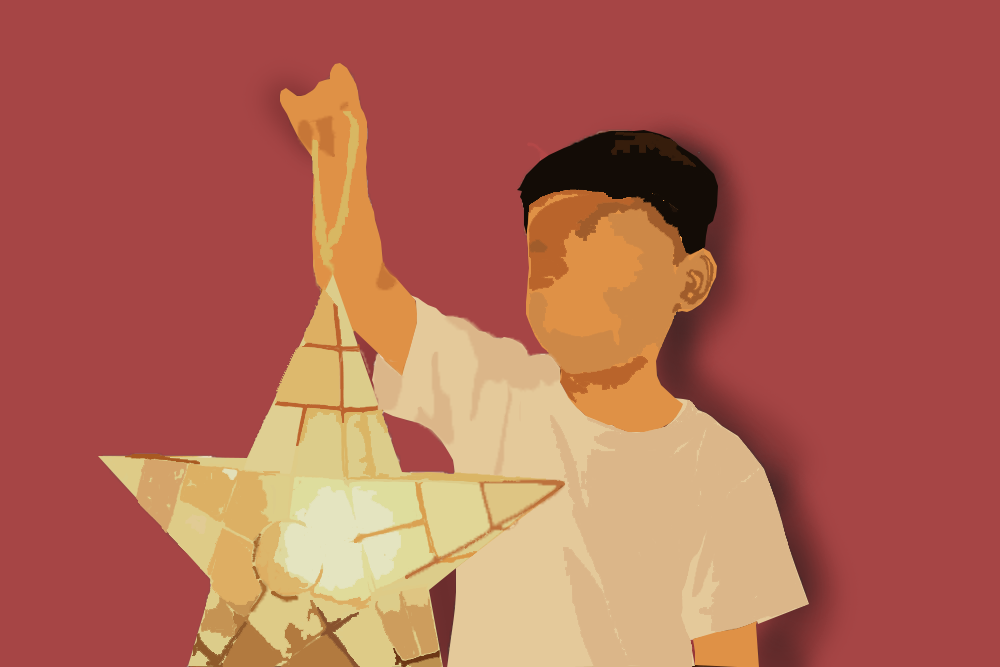Ever wished the Christmas season lasted longer? There is no other place around the world that celebrates this joyful and spirit-filled holiday longer than the Philippines. The tradition starts when “Hanging Amihan,” a wind from the Northeast, arrives in September. This wind marks the beginning of the holiday season, because it becomes cooler. Once the “-ber” months begin, you can see a parol hung in windows in our house.
What are parols?
Parols are star-shaped lanterns that are traditionally made with bamboo sticks, paper, or capiz shells. Parols come in various sizes and designs; you can make these out of almost anything.

Most parols have lights in the star or around it on a wreath surrounding the star. This tradition goes back to the infamous biblical story of the Nativity scene of Jesus’ birth, where the Northern Star is used to guide the three kings to Jesus’ manger at the stable. Symbolically during Misa de Gallo, the parols are used to light the way during the procession to the mass. Parols are now used to decorate our homes. You can usually see many Filipino households decorate their homes with these star-shaped lanterns through their windows. In my household, we have a lantern for almost every window.
What is Misa de Gallo?
As a Catholic, one of the traditions my family and I participate in every season is Misa de Gallo. Misa de Gallo, more commonly known as Simbang Gabi, is a nine-day Novena where mass is held every day before sunrise, typically around 5AM. This Novena takes place right before Christmas day; it starts on the December 16th and lasts until December 24th, Christmas Eve. We believe that if you attend mass for all 9 days, God grants you a wish for the holiday season. When I celebrate the holidays here in the states, after mass there is a fellowship, where we all gather to eat some delicious Filipino breakfast. We are served with salabat (Filipino ginger tea) or cinnamon hot cocoa with whipped cream on top. Waking up in the cold December weather (in Texas) at 5 o’clock in the morning, every day for 9 days, before Christmas if I may add, may not sound exciting to many, but I absolutely love it. I have to admit, for the first two days it is a struggle, but after that it becomes a routine and you begin to love it. I see my friends and eat some lugaw or longganisa. This is one of my favorite traditions; being surrounded by good food and good company at dawn. I have never experienced Simbang Gabi in the homeland firsthand, but I imagine it to be a lot better and more eventful.
Aside from pursuing a career in nursing, what is another thing [most] Filipinos are known for? Singing karaoke. During the Christmas season, carolers would travel from village to slums to busy streets to spread the holiday spirit to one another. They would make homemade instruments out of the simplest items that you never thought you would use to play music with to create the most beautiful music you have ever heard— from milk cans and aluminum bottle caps. This displays the characteristic of ingenuity Filipinos have.
Last but not least, who can forget the food? What’s a Christmas without some warm, homemade dishes, like pancit, kaldareta, bistek, and lechon? After completing Simbang Gabi, that same night, we have a feast called “Noche Buena.” It is an evening feast where family, friends, neighbors, almost everyone you know gather around to enjoy some good food and good company. Almost everyone you know, even your co-worker’s cousin, is invited to any Filipino gathering. I guess we can say we’re also known for our hospitality and food. And remember if you do get invited to a Filipino party this holiday season, don’t forget to say, “Maraming salamat po at Maligayang pasko sa lahat!”
Featured image from Pexels





Recent Comments